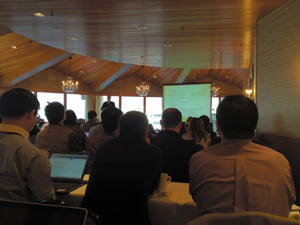 |
|||||||
|
|
|||||||
|
Global Standardization Activities Vol. 10, No. 8, pp. 43–46, Aug. 2012. https://doi.org/10.53829/ntr201208gls NTT's Activities in the GreenTouch ConsortiumAbstractThis article describes NTT's activities in GreenTouch, a consortium that is examining how to achieve a 1000-fold improvement in the per-bit energy efficiency of communications. The consortium's discussions cover a wide range from materials to methodologies. NTT, which had been an observer at GreenTouch Members Meetings, has joined in the consortium's activities by officially becoming a member in May 2012.
1. GreenTouch: mission and organizationWith network traffic growing exponentially, communication networks are expected to deliver greater efficiencies and lower power consumptions in concert with worldwide energy conservation trends. GreenTouch [1] is a consortium with the mission of demonstrating and delivering by 2015 a new low-energy network that achieves a 1000-fold improvement in per-bit energy efficiency. The consortium is examining many energy reduction and elimination technologies that are needed to fulfill this mission. GreenTouch, which has 61 members (as of June 2012), was founded in January 2010 by 13 members, led by Bell Labs and joined by network operators, university research organizations, governmental and non-profit research institutes, and equipment manufacturers (Fig. 1). Major network operator members include AT&T, France Telecom, China Mobile, and KT Corporation, and equipment manufacturer members include Alcatel-Lucent, Samsung, and Huawei. About half of the members are located in Europe and about a quarter come from Asia.
The organizational structure of the consortium’s Technical Committee is shown in Fig. 2. Working groups (WGs) and study groups (SGs) are formed in response to proposals from members after approval by the overseeing committee.
2. NTT’s involvementNTT formulated an environmental vision, THE GREEN VISION 2020 [2], as an initiative to further cut CO2 emissions associated with communication networks by a target date of 2020. Before this vision was drawn up, the Green R&D Committee, consisting of members of laboratories spanning many research and development (R&D) disciplines, had since August 2009 been exploring the technical development side of CO2 emission reductions and resource conservation in the areas of communication equipment, datacenters, offices, and homes (Fig. 3).
NTT Energy and Environment Systems Laboratories, the secretariat of the Green R&D Committee, and global production managers from NTT’s research planning departments have been attending GreenTouch Members Meetings as observers since the consortium’s founding in 2010 to monitor the direction of its technical discussions. NTT officially joined GreenTouch as a full member in May 2012. The Green R&D Committee secretariat selects representatives from NTT’s laboratories with close links to the technical discussions in GreenTouch WGs and SGs. These representatives examine approaches toward future energy efficiency improvements and application technologies along with energy efficiency studies done at their home laboratories, and they present NTT’s positions at the WGs and SGs. 3. Fourth GreenTouch Members Meeting in SeattleThe fourth GreenTouch Members Meeting and Open Forum were held in Seattle, Washington, USA, on November 14–17, 2011 (Photos 1 and 2). This was NTT’s first Members Meeting as an official member, and its representatives took part in discussions at three WG sessions closely related to technologies being studied by NTT. The topics discussed in the WGs and the committee in which NTT participated are briefly described below.
• Core Optical Networking and Transmission WG This WG discussed energy consumption models that account for node devices and link devices in wavelength-division-multiplexing (WDM) networks as well as setting targets and technical approaches in consideration of 2015 traffic volumes with respect to the energy consumed by transponders, cross-connect devices, and optical fiber amplifiers. • Core Switching & Routing WG This WG has launched a university-led study that includes improving the materials and components used in devices as an energy-conservation project for communication devices. There are also plans for a demonstration proof-of-concept project based primarily in Europe that will make use of all of this WG’s technologies. • Wireline Access WG This WG discussed future WDM passive optical networks (WDM-PONs) and other schemes based on current energy analyses of bit-interleaved PONs and Gigabit-capable PONs (GPONs) with respect to access networks from edge nodes to optical network units (ONUs). • Services, Applications and Trends Committee To better understand global traffic volumes in 2020, this committee held discussions about service categories and traffic forecasts in each service category with reference to publically available materials and testimonials from participating companies. The conclusions from these discussions are disseminated as needed to the WGs and used as inputs by the WGs for their technical discussions. 4. Concluding remarksGreenTouch is a highly influential consortium concerning the advancement of energy efficiency in the communications field, and its membership is growing amid the global trend toward reducing the burden we impose on the natural environment. The meetings are also expected to be highly significant in terms of preparation for standardization. NTT will press forward to improve future communication energy efficiencies in conjunction with its contributions to GreenTouch, by referring to and examining the positions in each WG, with respect to the R&D and technologies that it has accumulated to ensure high-quality communications. References
|
|||||||














